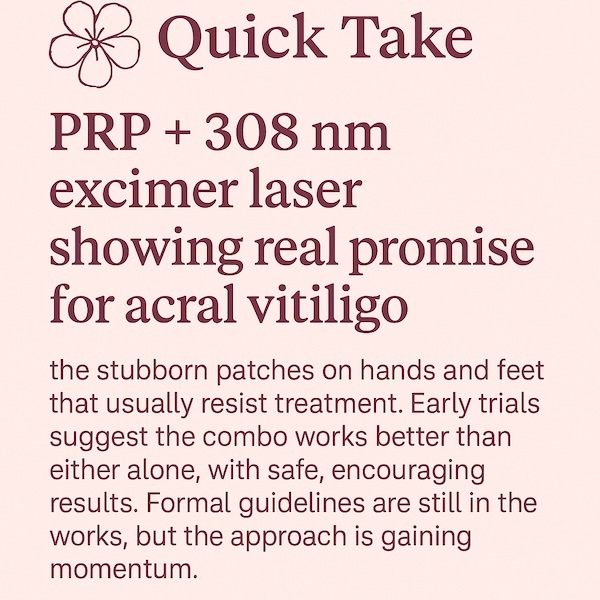New
Acral Vitiligo and Platelet-Rich Plasma: Your Questions Answered
PRP (platelet-rich plasma) combined with the 308 nm excimer laser is showing real promise for acral vitiligo—the stubborn patches on hands and feet that usually resist treatment. Early trials suggest the combo works better than either alone, with safe, encouraging results. Formal guidelines are still in the works, but the approach is gaining momentum.
Q: What is acral vitiligo and why is it so tough to treat?
Acral vitiligo shows up on the hands, feet, fingers, and toes—areas with lower blood flow and fewer active melanocytes. Because of that, these spots often resist standard treatments like corticosteroids, tacrolimus, or even phototherapy, making repigmentation much harder to achieve.
Q: What exactly is Platelet-Rich Plasma (PRP), and how does it help?
PRP is made from your own blood and packed with growth factors such as PDGF, TGF‑β, and VEGF. In vitiligo, it’s thought to calm local immune activity, encourage melanocytes to regenerate or migrate into white patches, and help skin tissue heal and stabilize—laying the groundwork for pigment to return.(1)
Q: What’s the role of the 308 nm excimer laser?
This laser delivers highly targeted UVB light, which switches on enzymes like tyrosinase, encourages melanocyte growth, and dampens the autoimmune attack behind vitiligo. When focused on affected areas, it can jump‑start repigmentation, especially in localized lesions.
Q: Can PRP be combined with other treatments?
Absolutely. Researchers are testing PRP with fractional CO₂ lasers, microneedling, and topical corticosteroids. These combinations enhance drug delivery and skin regeneration, often producing faster and more visible results—especially in areas that usually don’t respond well.
Q: What’s on the horizon for research?
The big goals are to finalize ongoing trials like NCT06394349, establish clear treatment protocols (how much PRP, how often, how long), and expand studies to children and patients with more resistant vitiligo. Some teams are even exploring “personalized PRP,” tailored to each patient’s biomarkers.
While PRP and combination therapies won’t work for everyone, the growing body of evidence offers real hope—especially for those with stubborn, treatment-resistant vitiligo. The science is still unfolding, but the progress is real.
— Yan Valle
Professor h.c., CEO VR Foundation | Author, A No-Nonsense Guide to Vitiligo
Suggested reading:
- Topical Treatments for Vitiligo: What We Know (and Still Don’t) About Their Safety
- Vitiligo Drug Pipeline Analysis and Market Insights: A Major Update
- ChatGPT in Healthcare: A Patient Survival Guide

FAQOther Questions
- Isn't it just a cosmetic disorder?
Contrary to popular belief, vitiligo is not merely a cosmetic issue but a complex autoimmune disorder that affects the body’s largest organ—along with other vital systems—and is...
- Shall I try low-fat diet for my vitiligo?
The link between dietary fat and autoimmune diseases like vitiligo is a compelling yet complex puzzle that continues to intrigue scientists. While the conversation is ongoing, o...
- What's better: laser or phototherapy?
Laser therapy is actually a type of phototherapy. Both rely on light to trigger changes in the skin, but they work differently. Phototherapy usually means a narrow-band UV (NB-...
Though it is not always easy to treat vitiligo, there is much to be gained by clearly understanding the diagnosis, the future implications, treatment options and their outcomes.
Many people deal with vitiligo while remaining in the public eye, maintaining a positive outlook, and having a successful career.
Copyright (C) Bodolóczki JúliaBy taking a little time to fill in the anonymous questionnaire, you can help researchers better understand and fight vitiligo.
